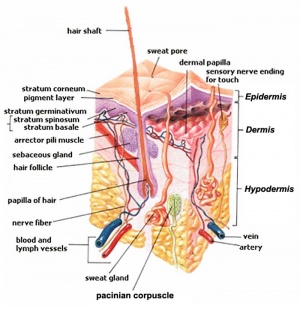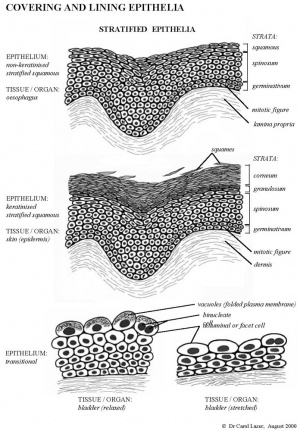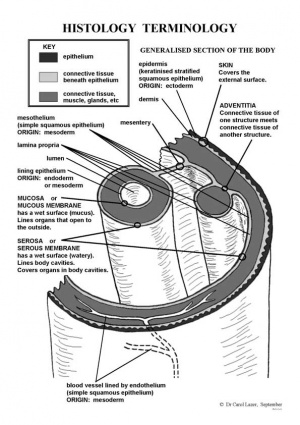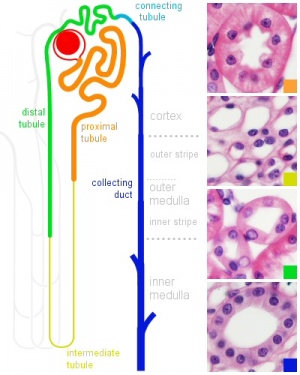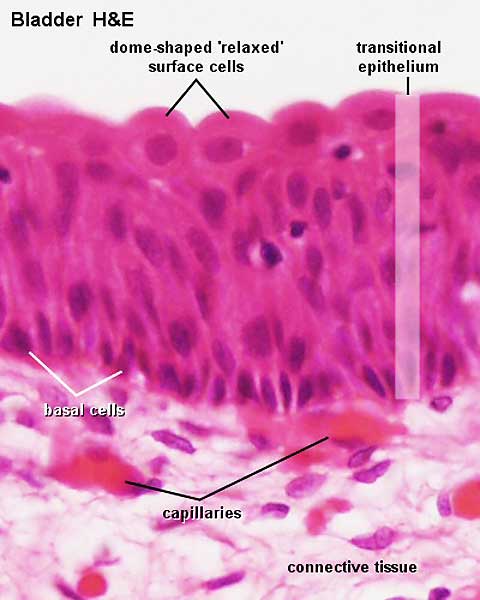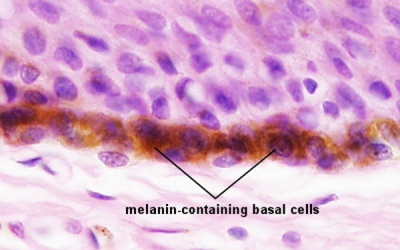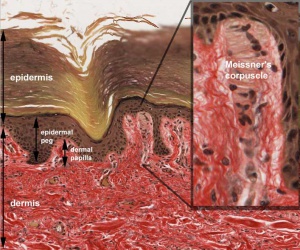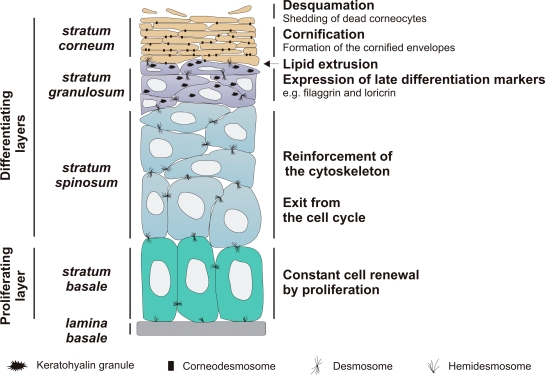Foundations - Histology Epithelia and Skin
Introduction
Background and Self-directed Learning for Medicine Foundations.
Practical - Histology Epithelia and Skin Virtual Slides by Patrick de Permentier.
This current page content is not part of the Foundations practical class.
Note - In Moodle on the virtual slide page the link to Trachea is currently not available.
Use this link - Virtual Slide - Trachea
2016 Prac 9 Histology of Epithelia and Skin
- Links: Histology Introduction | Histology Epithelia and Skin | Histology Stains | ANAT2241 Integumentary System | Histology Drawings
| Moodle Lab Slides
Note - Moodle icon links appearing below on this page go directly to Lab Slide. |
Objectives
Epithelia
- Obtain an understanding of the histological appearance of various types of epithelia based on their cellular shape and number of layers.
- To examine the histological appearance of 2 other unique types of epithelia namely pseudostratified and transitional.
- To demonstrate some sites where the types of epithelia can be located
- To demonstrate certain epithelial specialisations such as microvilli and cilia.
- Relate the morphology of the epithelia to their various functions.
Skin
- To know the microscopic structure of the skin e.g. epidermis, dermis and hypodermis.
- To know the histological differences between hairy (thin) and glabrous (thick) skin.
- To know the histology of associated structures e.g. eccrine and apocrine sweat glands, sebaceous glands, and hair.
- To know the histological features of some sensory receptors namely: Pacinian and Meissner
corpuscles.
Textbooks

|
Wheater’s Functional Histology. A Text and Colour Atlas 6th ed. by Young, B., O’Dowd, G. and Woodford, P. (2014)
Requires student log-in |
Epithelia
Epithelium forms continuous layers of cells that cover surfaces and line cavities of the body.
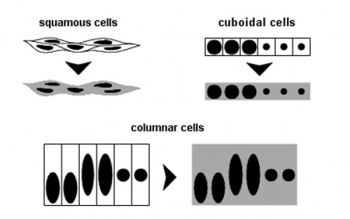
|
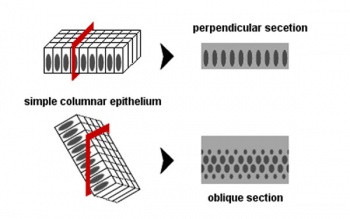
|
| Epithelia cell shape | Epithelia sectioning appearance |
Epithelia Classification
- The number of cell layers: a single layer = simple epithelium; epithelia composed of more than one layer = stratified epithelia.
- The shape of the component cells when seen in sections taken at right angles to the epithelial surface: the shape may be squamous (flattened), cuboidal (about equal dimensions), or columnar (taller than it is wide).
- The presence of surface specializations e.g. cilia, microvilli and keratin.
Simple Epithelium
Simple Squamous
Virtual slides: Distributing artery and vein and Aorta
Vein simple squamous epithelium. (Stain - Haematoxylin Eosin)
Simple Cuboidal
Virtual slides: Thyroid gland and Kidney
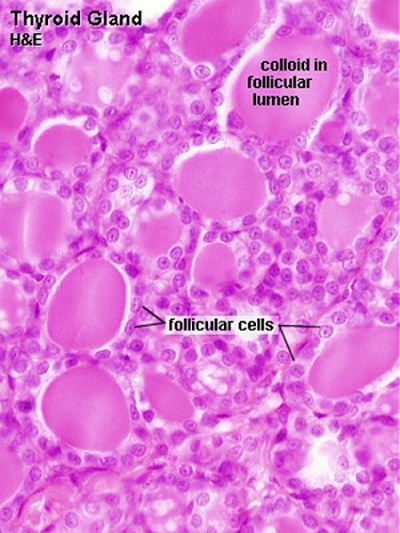
|

|
| Thyroid follicles | Renal tubules |
Kidney - distal and collecting tubule. (Stain - Haematoxylin Eosin)
See also Urinary Histology
Simple Columnar
Virtual slides: Fallopian tube-isthmus and Duodenum

Duodenum (Stain - Haematoxylin Eosin) |
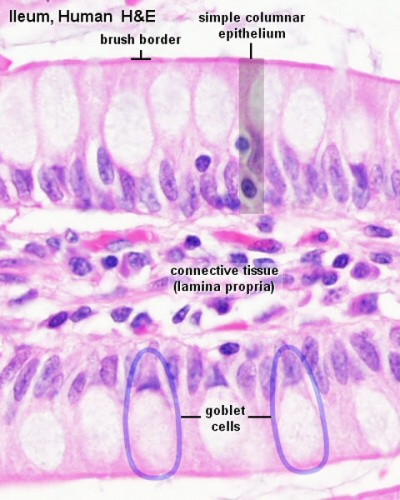
Ileum (Stain - Haematoxylin Eosin) |
Stratified Epithelium
Stratified Squamous Non-Keratinising
Virtual slides: Tongue-Foliate papillae and Cervix of uterus/vaginal canal
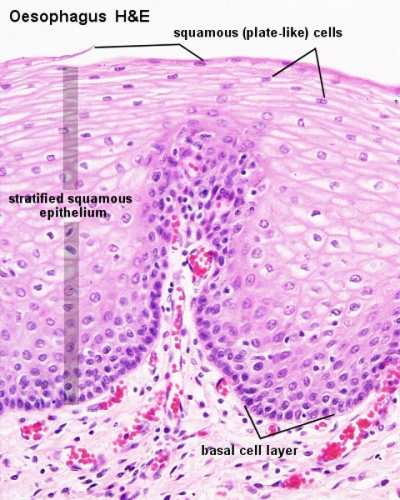
|
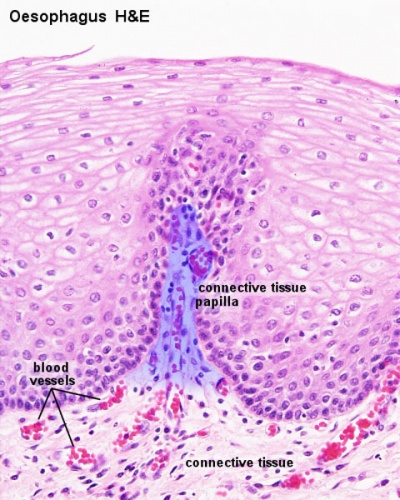
|
Stratified Squamous Keratinising
Virtual slide: Skin
See more in the Skin histology notes section below.
Stratified Cuboidal / Stratified Columnar
Virtual slides: Skin and Submandibular Gland
Parotid gland epithelium is an example of a stratified columnar epithelium.
Pseudostratified Columnar
This type is categorized as simple because all the epithelial cells make contact with the basement membrane, but not all cells reach the surface of the epithelium.
Virtual slides: Epididymis and Trachea
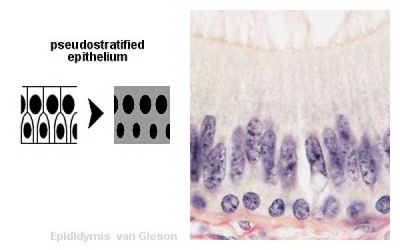
Epididymis |
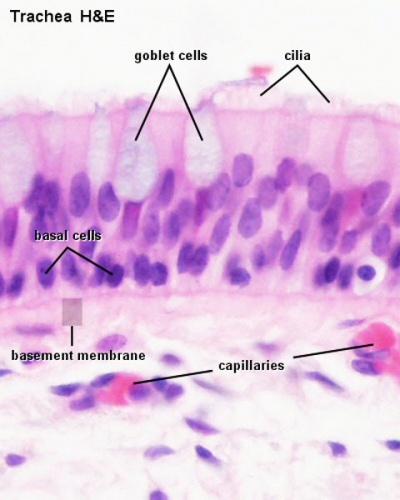
Trachea |
Transitional
Located only in the urinary system, this epithelium is composed of 5 or more cell layers. Those located basally are either low columnar or cuboidal.
Virtual slides: Urinary bladder (relaxed) and Urinary bladder (partly distended)
Skin
Virtual slide: Thick skin (human palm).
Virtual slides: Thin skin (human scalp LS and TS) and Skin (axillary, human)
Histology

Skin overview (Stain - Haematoxylin Eosin) |
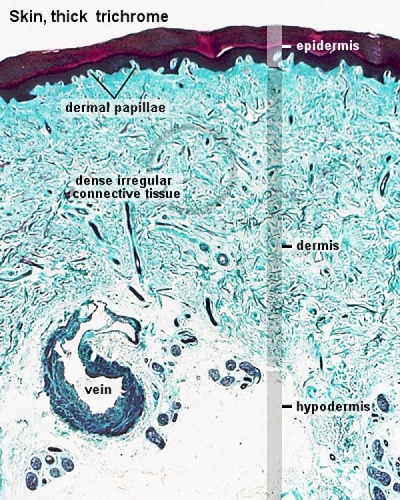
Skin overview (trichrome stain) |
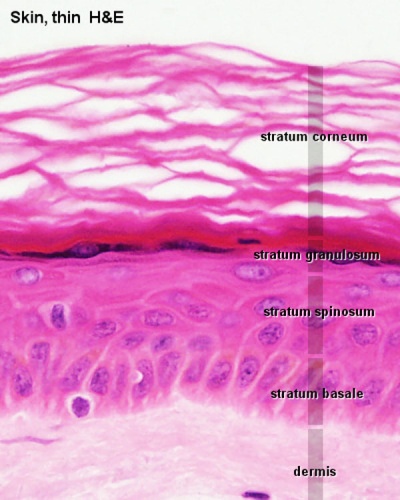
Epidermis (thin skin) |

Epidermis (thick skin) |

Epidermis and Dermis |

Hair follicle |
Pigmentation
Melanin in Basal Cell Layer
Glands and Hair
Gland Secretion Mechanisms

|

|

|
| Merocrine secretion | Apocrine secretion | Holocrine secretion |
Sensory
- Integument Histology Links: Adult Skin | Epidermis and Dermis | Thin Skin Epidermis | Thick Skin Epidermis | Elastic Fibres | Basal Cell Melanin | Foundations Practical Support | Integumentary System Development | Histology Stains
Additional Information - Keratinocyte Development
Additional Information - Epithelial Specialisations
Cilia
Trachea cilia (microtubule core, motile) <html5media height="350" width="800">File:Mouse trachea 01.mp4</html5media>
Microvilli
- termina web
- microfilament (actin) core, immotile
Stereocilia
- microfilament (actin) core, immotile
Terms
- apocrine gland - (sweat gland) proteinaceous secretion associated with hair (axilla, areola, genital and anal regions). Additional glands associated with eyelashes are called the glands of Moll (ciliary gland).
- arrector pili muscle - bundle of smooth muscle associated with hair follicle, inserts into the papillary layer of the dermis and attaches to the dermal sheath of the hair follicle.
- bulb - the hair follicle enlargement located at its deepest end, dividing cells form the hair and the root sheath.
- cilia - epithelia apical surface specialisations that are motile and move the overlying fluid. Cilia contain microtubules that are responsible for their movement, except in olfactory regions involved with smell and where they are not motile.
- collagen - major filamentous protein component of extracellular matrix that add strength to the connective tissue. There are many different forms (isoforms) of collagen that have different physical properties and tissue locations.
- columnar - cells are longer than they are wide.
- cuboidal - cells are about the same length and width.
- cutis - alternative term for the epidermis and the dermis layers of the skin.
- dermis - connective tissue middle layer of the skin, consists of two sublayers (papillary and reticular layers) that do not have a clear boundary.
- dermal papillae - interdigitation of the dermis with the epidermis.
- epidermis - epithelial outer layer of the skin.
- goblet cell - a mucus-secreting cell located in epithelia, the mucus acts as a lubricant (gastrointestinal tract) or a "trap" for particulates or organisms (respiratory). Named because their cell shape looks like a goblet, a curve-shaped cup.
- hair - (pili) in humans consists of vellus and terminal hairs.
- holocrine - form of gland secretion where the secretory cells eventually lyse (rupture) and are lost. On the skin these cells release sebum consisting mainly of lipid.
- hypodermis - (subcutis) connective tissue inner layer of the skin that binds it to underlying structures.
- integumentary - term for the skin and its appendages.
- Meissner's corpuscle - sensory receptors present in the skin, touch receptors located close to the epidermis (superficial dermis region) Meissner's corpuscle image
- microvilli - epithelia apical surface specialisations that increase the cell surface area, typically found in epithelia active in absorption. Microvilli contain actin filaments, which are in contact with the terminal web of the cell. The difference between microvilli (short) and stereocilia (long) is their length.
- merocrine gland - (sweat gland, eccrine sweat) simple tubular glands located at the border between the dermis and hypodermis. These glands regulate the body temperature.
- Pacinian corpuscle - sensory receptors present in the skin and in some mucous membranes). Mechanoceptors that respond to pressure or any mechanical stimulus deforming the corpuscle. Pacinian corpuscle image
- papillary layer - dermis sublayer that appears less dense and contains more cells lying close beneath the epidermis.
- rete pegs - (rete processes, rete ridges) epithelial extensions that project downward forming thickenings of the epidermis.
- reticular fibres - very delicate component of extracellular matrix that form fine support network to individual cells instead of thick bundles. They are also made from a form of collagen (type III).
- reticular layer - dermis sublayer that appears denser and contains fewer cells with thick collagen bundles lying parallel to the skin surface.
- root sheath - cell layers that surround the hair.
- sebaceous gland - holocrine gland associated with both the hair follicle and hairless parts of the skin (lips, cheek oral surface and external genitalia). Embedded in the dermis and are sites of infections (acne).
- simple - consisting of a single cell layer.
- squamous - flattened.
- stereocilia - not cilia they are epithelia apical surface specialisations that increase the cell surface area, typically found in epithelia active in absorption. The difference between microvilli (short) and stereocilia (long) is their length.
- stratified - consisting of several cell layers.
- terminal hairs - hair seen in obviously hairy parts of the body.
- thick skin - refers to the skin histology found on the palms of the hand and soles of the feet, do not contain hair. Note that this is used as a histological term not a measurement of overall skin thickness.
- thin skin - refers to the skin histology found on skin in all other regions beside palms and soles.
- vellus hairs - fine short hairs only lightly pigmented covering the body.
Additional Information
| Additional Information - Content shown under this heading is not part of the material covered in this class. It is provided for those students who would like to know about some concepts or current research in topics related to the current class page. |
External Links Notice - The dynamic nature of the internet may mean that some of these listed links may no longer function. If the link no longer works search the web with the link text or name. Links to any external commercial sites are provided for information purposes only and should never be considered an endorsement. UNSW Embryology is provided as an educational resource with no clinical information or commercial affiliation.
- Kierszenbaum, A. L., & Tres, L. L. (2012). Histology and cell biology: An introduction to pathology. Philadelphia, PA: Elsevier Saunders. Chapter 11. Integumentary System
- Blue Histology Epithelia | Skin
- UNSW Virtual Slides Medicine phase 1 (requires login for access). Histology Epithelia and Skin Virtual Slides
- UIOWA Virtual Slidebox of Histology Skin
Glossary Links
- Glossary: A | B | C | D | E | F | G | H | I | J | K | L | M | N | O | P | Q | R | S | T | U | V | W | X | Y | Z | Numbers | Symbols | Term Link
Cite this page: Hill, M.A. (2024, April 26) Embryology Foundations - Histology Epithelia and Skin. Retrieved from https://embryology.med.unsw.edu.au/embryology/index.php/Foundations_-_Histology_Epithelia_and_Skin
- © Dr Mark Hill 2024, UNSW Embryology ISBN: 978 0 7334 2609 4 - UNSW CRICOS Provider Code No. 00098G
